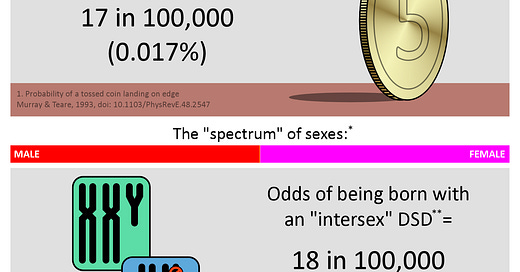I stumbled across an interesting study the other day, looking at what I think is essentially the quintessential example of a real-world binary that people fall back to: tossing a coin.
We all understand that, for practical purposes, the result is binary: heads or tails. We know there is a teeny, tiny, theoretical chance that it could land on its edge, but this is so rare that, despite tossing a coin hundreds of times in a lifetime, most of us will never see this happen firsthand.
The study in question, by Daniel B. Murray and Scott W. Teare looks at the probability of a tossed coin landing on its edge, and they conclude the chances of this are about 1 in 6,000 or, to express it a different way - about a 0.017% chance.
And I noticed that this is remarkably similar to the proportion of people who are born with DSDs (Differences of Sexual Development) - which is, according to this study by Leonard Sax, around 0.018%.
I don’t think anyone would describe the results you get from tossing a coin as a “spectrum”. And so this seemed like a great analogy to get across the binary nature of sex in a more tangible way.
Anyway, me being me, I made an infographic:
Please feel free to share! High res version is available here.
References
Sax, L. (2002). How common is intersex? a response to Anne Fausto-Sterling. J Sex Res. 39 (3): 174-8. doi: 10.1080/00224490209552139
Murray, D. B. and Teare, S.W. (1993). Probability of a tossed coin landing on edge. Phys. Rev. E 48, 2547. doi: 10.1103/PhysRevE.48.2547
Updates / Version History
13th June 2023
Updated graphic to clarify that the 0.018% refers to a subset of DSDs that result in “intersex” conditions / phenotypes.





Love this! The problem is that the Fausto-Sterling number (something like 1.7%, and the basis for the whole “intersex is as common as red hair” trope) is what is “out there” as the consensus number. And the Sax paper is good but as I recall has some unfortunate terminology that will likely make the gender ideologues dismiss it.
It seems like a philosophical mistake to say that sex "is" a spectrum or "is" a binary as if there was an objectively correct One True Categorization Scheme and the job of scientists was to discover the pre-existing True Categories. If you believe in the reductionist physicist's view of nature, everything that happens in the physical world is entirely determined by laws of physics, where the only categories involved in the laws are things like fundamental particle types, none of our higher-level categories play any role at all. So any higher-level categories have to be seen as useful human constructs, justified in pragmatic terms (for example, astronomers revised the definition of 'planet' in 2006 in a way that excluded Pluto, and they would no doubt consider it silly to imagine the new definition could be 'objectively wrong' or 'objectively right').
If you're studying evolutionary biology it certainly makes sense pragmatically to use a binary gamete-based notion of sex in that context, since all other ways in which the average male in a population differs from the average female can be understood as an evolutionary consequence of different mating strategies which are favored depending on whether the organism has large or small gametes. But if you are specifically interested in studying the effects of hormone levels in the uterus on the development of sexual characteristics in an embryo/fetus, with an eye towards understanding how statistically unusually hormone levels tend to lead to intersex characteristics, a spectrum definition might be more useful in that different context. Either way, there's no truth about how collections of fundamental particles should "really" be divided up into higher-level categories independent of such pragmatic considerations.